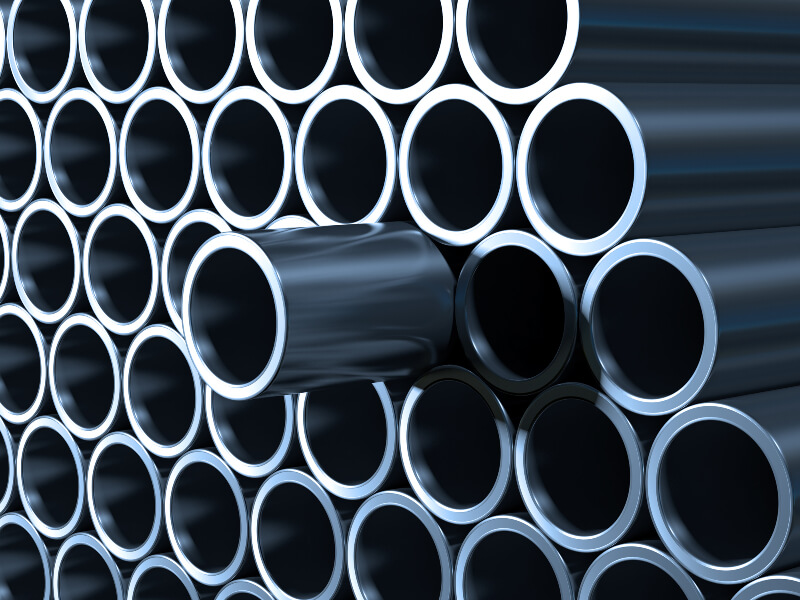
The civil industry uses a variety of materials, with steel being one of the most important. It's used in all types of structures and for a variety of purposes, as it's a highly versatile metal. In this context, we need to understand one of its most common varieties and understand what stainless steel is.
This material has some central characteristics that make it ideal for a variety of purposes, both in construction and in other areas, such as electronics, jewelry, textiles, etc. And it continues to acquire new varieties and formulas, which confer more specific qualities.
Follow and better understand the properties of stainless steel, its types and applications.
It is a low-carbon steel alloy with chromium added, which makes up between 10% and 30% of the alloy. It may also contain other elements, such as sulfur, nickel, molybdenum, titanium, aluminum, niobium, nitrogen, copper, phosphorus, or selenium, which confer very specific qualities.
Check out some of the main qualities of stainless steel and how they impact its application below.
The main function of chromium in this alloy is to form a chromium oxide film on the surface of the steel. This outer layer provides greater corrosion resistance. Hence the name "stainless steel," steel that does not oxidize. This is its most important characteristic. For example, the use of stainless steel in coastal regions It is quite common, as the material is not as affected by sea air.
Another feature that makes this type of steel more attractive is its ease of cleaning. The chromium oxide film on its surface regenerates after being damaged, eliminating grooves where dirt and bacteria tend to form. This is ideal for applications in hospital industry or in food industry, where hygiene is always a priority.
Like many other types of steel, stainless steel is also quite malleable and versatile. Understanding stainless steel better means knowing that it can take on many different forms, depending on the project's needs. This is crucial for structures that require precise measurements across all their components.
How do you know if it's stainless steel? In practice, there are dozens of types of stainless steel, varying according to changes in their composition and structure. However, they fall into five general categories. See below.
This is the most widely used stainless steel today, composed of at least 16% of chromium and 6% of nickel. It has a primary austenite microstructure, a solid solution of iron and carbon that forms at temperatures of 723°C. As you might imagine, this is a steel with high strength and toughness, especially at high temperatures.
Alternatively, you can also opt for ferritic stainless steel, which has an even higher corrosion resistance rating but slightly less resilience and durability. Furthermore, it is a magnetic alloy. It consists of 10.5% to 27% of chromium, but nickel is trace. Some variations may also include aluminum or titanium in the alloy.
Ferritic and austenitic stainless steels have important and complementary characteristics. This is where duplex comes in, a type of stainless steel that is a blend of both. This combination provides high weldability and tensile strength, making it ideal for complex, custom-made structures that are exposed.
Martensitic stainless steel has a higher carbon content and lower chromium content. Its weldability is reduced, making it more difficult to mold. However, it has good hardenability, making it easier to heat treat. Like ferritic, it is also a magnetic alloy.
This is another type of stainless steel that combines two alloys as a base. In this case, it combines the qualities of martensitic and austenitic steel. Its hardening, in turn, occurs with the addition of other components, such as molybdenum or aluminum. With proper heat treatment, this alloy can also acquire high tensile strength.
To the advantages of stainless steel are quite evident, especially its corrosion resistance. Therefore, it is often used in various environments and contexts, especially in civil construction.
See here some of the main applications of stainless steel.
The most common use of steel in any space is in structural construction. It often serves as a skeleton for various components of a building or as part of the support. This is the case, for example, with reinforced concrete.
Stainless steel is particularly important for structures that are more exposed, at risk of corrosion and small cracks over time. Because this material doesn't oxidize easily and has a limited degree of regeneration, it tends to be more durable, even under more severe conditions.
Various parts and components, such as pins, screws, and nails, are also commonly made of stainless steel. The reason is simple: it's a strong and durable material, ideal for reinforcing joints between larger parts. Even a highly resistant plate won't last long if the screws holding it in place aren't strong and durable enough.
Finally, you will also find different types of stainless steel being used as a coating for other materials, either as a clad layer over other metals or as plates that cover structures.
This is one of the most efficient applications of stainless steel, as it allows you to take full advantage of the qualities offered by other materials, including different metals, but without sacrificing the corrosion resistance offered by stainless steel.
Now you know what stainless steel is, the main types, and their most important characteristics. Understanding the specific characteristics of each material is crucial when planning a construction project, as each variation has its own qualities. Depending on the location and purpose, choosing the best type makes all the difference.
Want to stay informed about steel and construction? Check out more blog content and learn about Ceará Steel Group on our website!